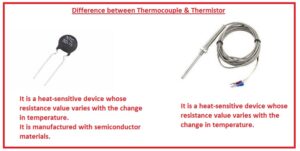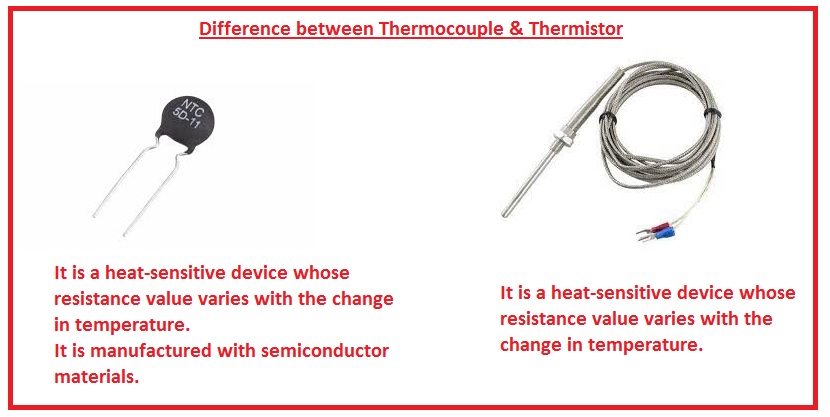 Hello, friends, I hope you all are doing great. In today’s tutorial, we will discuss the difference between Thermocouples & thermistors. thermocouple has a detecting element is the voltage which induces into a different metallic plate. While in the case of thermistors, the temperature-detecting element is resistance. Both these components are devices used to detect the temperature with different working operations. If the temperature varies the resistance of the material used in the thermistor varies. For a change in temperature, voltage produces among the electrodes of different substances in the thermocouples.
Hello, friends, I hope you all are doing great. In today’s tutorial, we will discuss the difference between Thermocouples & thermistors. thermocouple has a detecting element is the voltage which induces into a different metallic plate. While in the case of thermistors, the temperature-detecting element is resistance. Both these components are devices used to detect the temperature with different working operations. If the temperature varies the resistance of the material used in the thermistor varies. For a change in temperature, voltage produces among the electrodes of different substances in the thermocouples.
In today’s post, we will have a detailed look at both thermocouples and thermistors with the detailed and find their difference. So let’s get started with thermocouple vs thermistor.
Difference Between Thermocouple & Thermistor
Thermocouple
- There is 2 different electric connections are used in thermocouples to make electrical connection
- It works on the feedback effect to find the voltage after measuring the temperature
- They are called temperate sensors
- Normally available devices are less costly and used to measure different values of temperatures.
- They work on self-excitation and have no need for separate supplies.
- They have some drawbacks in that they are less accurate
- They are employed in different industries and measure tempered at kilns and steam coming from the turbine
- They also work in homes in thermostats
- Its temperature measurement range is from -50 centigrade to 250 centigrade.
- The response time of this module is 0.12 to 10s.
- When it is used to find temperature voltage induces between the electrons of thermocouples which are of different materials.
- The material used for the construction of thermocouples are Copper, iron, Constantan, Chromel, Alloys of metals like Chrome, etc
- It provides high accuracy than the thermistor.
- In instruments like ovens, refrigerators, fire alarms it uses.
- Its common applications are temperature regulation, temperature calculation, and temperature compensation.
- The characteristic curve of a thermocouple is non-linear in case of a negative temperature coefficient.
- Its price is larger than the thermistor.
Definition of Thermocouple
- The thermocouple is a temperature sensor that operates through the calculation of voltage produced among two different metals connected at two points.
- The voltage generated through the thermocouple varies according to temperature permitting it to measure changes in temperatures
- Therocompuples are mostly used in high-temperature applications for example in industries since they have the ability to work in harsh conditions and can bear high temperature
Thermocouple Features
| Feature | Description |
|---|---|
| Temperature range | Thermocouples have the ability to measure different values of temperature from -200°C to over 2300°C can be measured |
| Accuracy | Its accurate temperature-measuring ability makes it useful for high-temperature projects where other sensors do not work accurately |
| Response time | It provides a high-speed response time which means has the ability to detect and respond to any change in temperature |
| Rugged design | Their structure is such that can be operated in harsh environments that make them best for industries operation |
| Ease of use | Its simple structure thermocouple is simple so preferred by hobbyists and professionals. |
| Cost | They are less costly than other sensors so used in different projects |
Thermistor
- It is a heat-sensitive device whose resistance value varies with the change in temperature.
- It is manufactured with semiconductor materials.
- The detective element of the thermistor is resistance.
- It is constructed with Manganese, nickel or cobalt oxides, and semiconductor material.
- It provides high accuracy. So we can measure a small change in temperature due to the negative temperature coefficient.
- It provides a fast response time.
- Its accuracy is less than the thermocouple.
- Its measurable temperature range is two hundred centigrade to twelve fifty centigrade.
- Its response time is 0.2 to ten seconds
- The characteristic curve is linear.
- It is used to find the temperature of devices used in a home.
- Its measured temperature range is -60 to 15 centigrade.
- It has two types NTC and PTC NTC resistance drops with temperature rise and in PTC resistance rises with temperature rise.
- PTC used to control overcurrent and used in a series combination
- It uses in industries to find the temperature of machines.
- Its common applications are measurement and regulation of temperature.
Definition of Thermistor
- The thermister is a category of resistor that shows sensitive behavior for temperature changes. It operated through changes in its electrical resistance according to temperature change
- As the temperature increase, the resistance of the thermistor reduces, and with temperature decrease resistance increases
- It makes thermistors beneficial for the calculation of temperature in different applications like medical instruments and different electronic circuits
- Thermistors have different types such as NTC and PTC thermistors that come with different features and applications
Thermistors Features
| Feature | Description |
|---|---|
| Temperature sensitivity | It is sensitive to temperature variation so it is the best option to use temperature calculation |
| Wide temperature range | It has the ability to measure temperature from -90°C and 130°C. |
| Small size | it is a small size and compact structured device so it can be easily integrated with electronic devices and projects that have limited operating area |
| Fast response time | its time response is high speed so it can fastly operate and respond to changes in temperature |
| Low cost | These are less costly modules than other temperature sensors so they are cost-effective options for different applications |
| Easy to use | Thermistors’ use is simple and easy and needs less setup causing them to be best for engineers and hobbyists. |
thermistor vs thermocouple
| Feature | Thermocouple | Thermistor |
|---|---|---|
| Principle | It measured the voltage produced by two different metals | It calculates semiconductor resistance |
| Temperature range | It can measure different temperatures values from -200°C to more than 2300°C | It can measure temperatures -50°C to 150°C |
| Accuracy | It is accurate and used in high temperature | It is accurate but less than a thermocouple for high temperatures |
| Response time | It provides a fast response time used for dynamic temperature values | Its response time is slow best for r steady-state temperature calculations |
| Sensitivity | It is less sensitive but can measure | It is highly sensitive and can be used only for low temperatures |
| Durability | It is a Rugged design, used in harsh conditions | It is fragile and damaged through harsh conditions |
| Cost | It is less costly than other temperatures sensors | It is a costly device |
FAQs
Are thermocouples more accurate than thermistors?
- Thermocouples are considered more than thermistors, especially in high-temperature conditions. Though the accuracy of both sensors depends on the application and temperature range
What is the difference between a thermistor and a thermocouple and RTD?
- The thermistor calculates temperature through the detection of change in resistance, while the thermocouple finds temperatures through voltage produced by two different metals.
- RTD or resistance temperature detector measures temperatures through changes in resistance of a metallic wire
What is the advantage of a thermistor over a thermocouple?
- Thermistors are more sensitive then temperature variations than thermocouples so they are the best option for projects where accurate temperature control needs. Thermistors are less costly than thermocouples
Working principle of thermistor and thermocouple?
- Thermistors operate by measuring variation in resistance with temperature variation, while thermocouples operate by measuring the voltage produced through two different metals which are connected at the measuring junction
Thermistor vs thermocouple accuracy?
The thermistors operate through the calculation of changes in resistance with temperature varies, while thermocouples operate through the calculation of voltage produced by two different metals which are connected at the measuring junction
That is all about the difference between thermocouples and thermistors. I tried my level best to make simple this post for you. If you have any queries ask in the comments. Thanks for reading. Have a good day.








